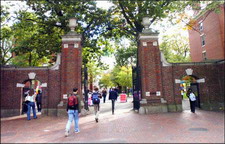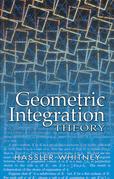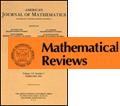 The website is in construction. New files will be uploaded as soon as they are available.
The website is in construction. New files will be uploaded as soon as they are available.
HAssLER WHITNEY
New York, New York 1907 - Princeton, New Jersey 1989

- Brief scientific biography
- Contributions to Education
- Relevant bibliography
- Publications on the teaching of mathematics
Brief scientific biography

Whitney-Gilman Ridge
Hassler Whitney was born 23 March 1907 in New York City. Both of his grandfathers, the philologist William D. Whitney and the astronomer Simon Newcomb, were members of the U.S. National Academy of Sciences, to which Whitney was elected in 1945. Whitney received bachelor's degrees in philosophy (1928) and music (1929) from Yale University. A keen mountaineer all his life, he made a famous climb while still an undergraduate, with his cousin Bradley Gilman, of a cliff in New Hampshire. The cliff was later named the Whitney-Gilman Ridge.

Harvard Yard gate

Whitney's work in topology was wide-ranging and innovative. His first research, a byproduct of his dissertation, was in graph theory; he introduced the notion of duality, which he used to characterize planar graphs (1933), and developed a theory of linear dependence that led to the theory of matroids (1935). He also did early work on the singularities of mappings between n-dimensional Euclidean spaces that turned out to be important for catastrophe theory. His most famous work concerned his theory of differentiable manifolds and its related machinery in algebraic and differential topology (see Zund, 1999, for details). After the Second World War, Whitney turned his attention to the interaction of algebraic topology with integration theory (1957) and then to complex global analysis (1972), making major contributions in both fields.


Contributions to education


Ash Street School, Manchester, NH
"The most pressing need I see is for us to face fully the consequences of interventions we make, and hold up on those with bad results. I speak, of course, of mandating more work in mathematics for failing students, raising standards for these without helping them toward meeting the standards, and starting mathematics teaching at an earlier age. It is unthinkable to market drugs without a thorough study of all effects; in education I see no parallel concern, though there should be" (WHITNEY, 1985b, p. 233)Whitney (1986) saw the purposes of learning mathematics as being distorted in many classrooms:
"Mathematical reasoning is becoming steadily more important in many domains; hence a basic need is for students to group in power in such reasoning. In addition, they must gain control over their work, see interrelations with other aspects of the subject, and communicate well with colleagues and others about these matters. . . . In the usual classroom, however, the student's focus is elsewhere. . . . The student's aim is to try to remember particular patterns of thought coming from reasoning, but to disregard the reasoning from which they came. Thus the essence of the process is lost". (pp. 129-130)

"One must find practical ways to move towards reform, leaving most of the present teaching unchanged (at least at the start). Not only the students, but also the professors and others must be considered".
"We push at the students to make them learn; it does not work. Pushing at the professors to teach differently will also fail. Pressures have too much that is negative. We need positive ways; and these must grow by themselves, not be forced. Humans grow through care and love during long periods; the same is true throughout nature". (p. 139)
Relevant bibliography
H. WHITNEY 1933, Planar graphs, Fundamenta Mathematicae, 21, 73-84
H. WHITNEY 1935, On the abstract properties of linear dependence, American Journal of Mathematics, 57, 509-533
H. WHITNEY 1936, Differentiable manifolds, Annals of Mathematics (2nd Series), 37, 645-680
H. WHITNEY 1957, Geometric integration theory, Princeton, NJ, Princeton University Press
H. WHITNEY 1968a, The mathematics of physical quantities: Part 1: Mathematical models for measurement, American Mathematical Monthly, 75, 115-138
H. WHITNEY 1968b, The mathematics of physical quantities: Part 2: Quantity structures and dimensional analysis, American Mathematical Monthly, 75, 227-256
H. WHITNEY 1972, Complex analytic varieties, Reading, MA, Addison-Wesley
H. WHITNEY 1985a, Letting research come naturally, Mathematical Chronicle, 14, 1-19
U. D'AMBROSIO 1989, The visits of Hassler Whitney to Brazil: Hassler Whitney, in Memoriam, Humanistic Mathematics Newsletter, 4, 8
L.P. BENEZET 1935a, The teaching of arithmetic 1: The story of an experiment, Journal of the National Education Association, 24, 241-244
L.P. BENEZET, 1935b, The teaching of arithmetic 2: The story of an experiment, Journal of the National Education Association, 24, 301-305
L.P. BENEZET, 1936, The teaching of arithmetic 3: The story of an experiment, Journal of the National Education Association, 25, 7-8
J. EELLS, D. TOLEDO (edited by) 1992, Hassler Whitney: Collected papers, 1-3, Boston, Birkhäuser
J. DIEUDONNé 1989, A history of algebraic and differential topology: 1900-1960, Boston, Birkhäuser
G. FOWLER 1989 (May 12), Hassler Whitney, geometrician: He eased 'mathematics anxiety', The New York Times, B10
F.M. HECHINGER 1986 (June 10), Learning math by thinking, The New York Times, C1.
A. LAX 1989, Hassler Whitney 1907-1989: Some recollections 1979-1989, Humanistic Mathematics Newsletter, 4, 2-7
R. THOM 1990, La vie et l'oeuvre de Hassler Whitney, Comptes rendus de l'Académie des sciences Paris Sér. Gén. Vie Sci., 7, 473-476
J.J. O'CONNOR, E.F. ROBERTSON 2005, Hassler Whitney, retrieved from the MacTutor History of Mathematics Archive web site:
http://www-history.mcs.st-andrews.ac.uk/Biographies/Whitney.html
J.D. ZUND 1999, Whitney, Hassler, American National Biography, 23, 303-304, retrieved from the American National Biography web site:
http://www.anb.org/articles/13/13-02523.html
Publications on the teaching of mathematics
H. WHITNEY 1973, Are we off the track in teaching mathematical concepts?, in A.G. Howson (edited by), Developments in mathematical education: Proceedings of the Second International Congress on Mathematical Education, Cambridge, Cambridge University Press, 283-296
H. WHITNEY 1985b, Taking responsibility in school mathematics education, Journal of Mathematical Behavior, 4, 219-235
H. WHITNEY 1986, Coming alive in school math and beyond, Journal of Mathematical Behavior, 5, 129-140, also published in 1987 in Educational Studies in Mathematics, 18, 229-242
H. WHITNEY 1989, Education is for the students' future (draft), Humanistic Mathematics Newsletter, 4, 9-12
Author
Jeremy Kilpatrick
University of Georgia
jkilpat@uga.edu
